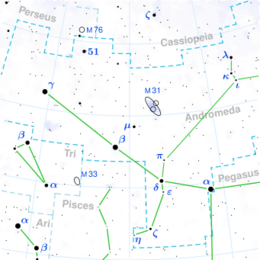Astronomy:32 Andromedae
| Observation data Equinox J2000.0]] (ICRS) | |
|---|---|
| Constellation | Andromeda |
| Right ascension | 00h 41m 07.18431s[1] |
| Declination | +39° 27′ 31.1886″[1] |
| Apparent magnitude (V) | 5.30[2] |
| Characteristics | |
| Evolutionary stage | giant star |
| Spectral type | G8 III[3] |
| B−V color index | 0.891±0.004[2] |
| Astrometry | |
| Radial velocity (Rv) | −5.1±0.3[4] km/s |
| Proper motion (μ) | RA: −14.083[1] mas/yr Dec.: −3.218[1] mas/yr |
| Parallax (π) | 9.8414 ± 0.1485[1] mas |
| Distance | 331 ± 5 ly (102 ± 2 pc) |
| Absolute magnitude (MV) | 0.12[2] |
| Details[5] | |
| Mass | 2.81±0.12 M☉ |
| Radius | 12.16±0.51 R☉ |
| Luminosity | 90.2±7.2 L☉ |
| Surface gravity (log g) | 2.73±0.04 cgs |
| Temperature | 5,107±37 K |
| Metallicity [Fe/H] | −0.15±0.10 dex |
| Rotational velocity (v sin i) | 1.7[6] km/s |
| Age | 420±40 Myr |
| Other designations | |
| Database references | |
| SIMBAD | data |
32 Andromedae, abbreviated 32 And, is a star in the northern constellation of Andromeda. 32 Andromedae is the Flamsteed designation. It is faintly visible to the naked eye with an apparent visual magnitude is 5.30.[2] The distance to 32 And, as estimated from its annual parallax shift of 9.8 mas,[1] is around 331 light years. It is moving closer to the Earth with a heliocentric radial velocity of −5 km/s.[4]
With an age of 420 million years, this is a red giant star with a stellar classification of G8 III,[3] indicating it has consumed the hydrogen at its core and evolved off the main sequence. It has 2.8 times the mass of the Sun and has expanded to 12 times the Sun's radius. The star is radiating 90 times the Sun's luminosity from its enlarged photosphere at an effective temperature of 5,107 K.[5]
References
- ↑ 1.0 1.1 1.2 1.3 1.4 1.5 Brown, A. G. A. (August 2018). "Gaia Data Release 2: Summary of the contents and survey properties". Astronomy & Astrophysics 616: A1. doi:10.1051/0004-6361/201833051. Bibcode: 2018A&A...616A...1G.
- ↑ 2.0 2.1 2.2 2.3 Anderson, E.; Francis, Ch. (2012), "XHIP: An extended hipparcos compilation", Astronomy Letters 38 (5): 331, doi:10.1134/S1063773712050015, Bibcode: 2012AstL...38..331A.
- ↑ 3.0 3.1 Harlan, E. A. (December 1981), "MK classifications for F- and G- type stars. IV.", Astronomical Journal 86: 1896–1897, doi:10.1086/113068, Bibcode: 1981AJ.....86.1896H.
- ↑ 4.0 4.1 de Bruijne, J. H. J.; Eilers, A.-C. (October 2012), "Radial velocities for the HIPPARCOS-Gaia Hundred-Thousand-Proper-Motion project", Astronomy & Astrophysics 546: 14, doi:10.1051/0004-6361/201219219, A61, Bibcode: 2012A&A...546A..61D.
- ↑ 5.0 5.1 Reffert, Sabine et al. (2015), "Precise radial velocities of giant stars. VII. Occurrence rate of giant extrasolar planets as a function of mass and metallicity", Astronomy & Astrophysics 574: A116, doi:10.1051/0004-6361/201322360, Bibcode: 2015A&A...574A.116R.
- ↑ De Medeiros, J. R. et al. (November 2000), "Rotation and lithium in single giant stars", Astronomy and Astrophysics 363: 239–243, Bibcode: 2000A&A...363..239D.
- ↑ "32 And". SIMBAD. Centre de données astronomiques de Strasbourg. http://simbad.u-strasbg.fr/simbad/sim-basic?Ident=32+And.
External links
 |

